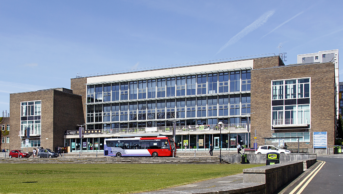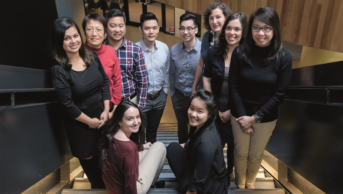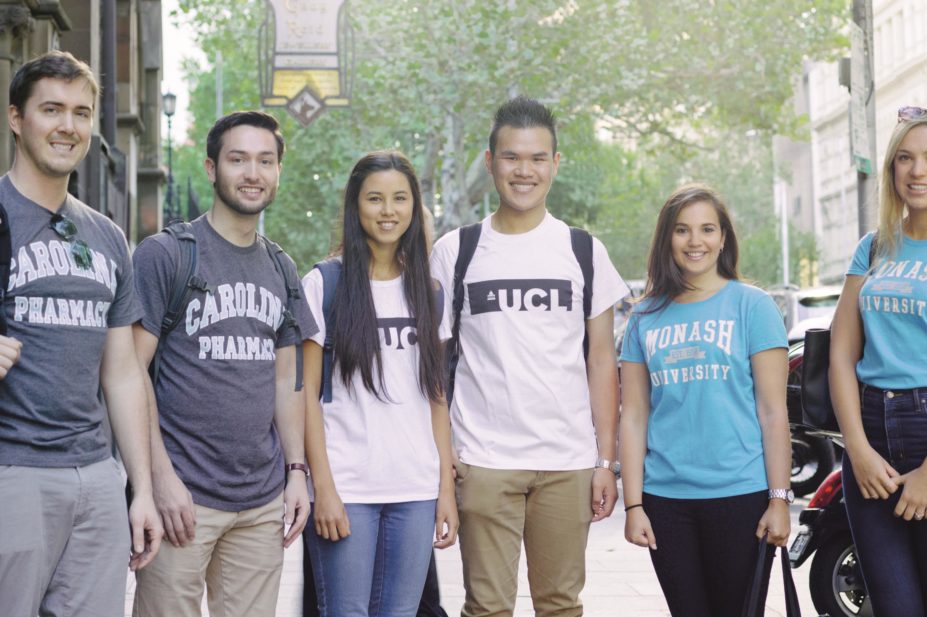
PharmAlliance
In early 2014, the deans of two pharmacy schools had a chance meeting in Shanghai. Bill Charman of Monash University in Melbourne Australia was in China for work. It just so happened that Bob Blouin, of the Eshelman school of pharmacy at University of North Carolina at Chapel Hill, known to have a similar philosophy to education and practice as Monash, was visiting at the same time.
“We quickly developed this kindred spirit,” says Blouin. “If only we could share our ideas more openly across our organisations and work more strategically together to pursue large problems that we could not pursue on our own.”
They agreed to meet again, but next time to involve Duncan Craig, director of the school of pharmacy at University College London — a school with a longstanding relationship with Monash University in research and teaching. The discussion soon turned to the ways the three universities could work together, such as education, research initiatives, and promoting professional practice in pharmacy and pharmaceutical science.
To be an absolutely top rate pharmacy school you have to be able demonstrate that you are contributing to the profession as well
Little over a year later, in March 2015, the three schools have signed a five-year memorandum of understanding (MoU) that provides the framework for the creation of a partnership called PharmAlliance. By combining their strengths and respective reputations, they could become a voice for change within the profession of pharmacy, one that could be heard across the world.
The three institutions regard excellence for a pharmacy school in much the same way. “You’ve got to be good at everything,” says Craig. “You have got to be good at teaching, research and also, as we are part of a healthcare profession, to be an absolutely top rate pharmacy school you have to be able to demonstrate that you are contributing to the profession as well.”
The schools are trying to exploit their unique strengths, too. For instance, UNC-Chapel Hill has considered whether it should set up a similar structure to Monash for preclinical work but, at least for now, it has decided not to invest in that area and to use the resources at Monash. “We trust the people, we know the quality of their work. We know it’s going to be more than just contract work, it’s going to dive deeper into the science,” says Blouin.
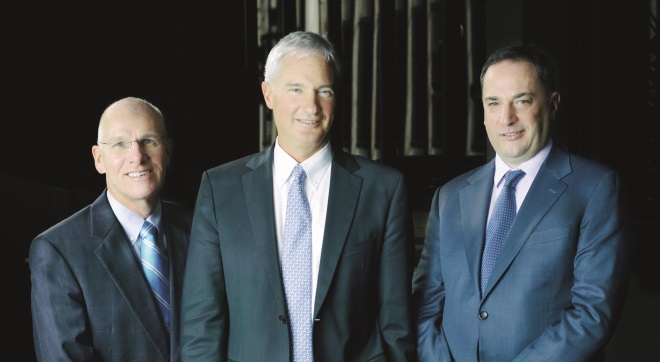
Source: PharmAlliance
(From left to right) Bob Blouin, dean of the University of North Carolina at Chapel Hill’s Eshelman school of pharmacy, Bill Charman, dean of Australia’s Monash University faculty of pharmacy and pharmaceutical sciences, and Duncan Craig, director of the University College London school of pharmacy in the UK
Joining forces
Universities have two major challenges: to provide high-quality education to their students for the labour market and to conduct research that solves real-world problems, according to Lidia Borrell-Damian, director of research and innovation at the European University Association, a Brussels-based body that represents 800 universities in Europe.
Universities are encouraged to seek out other sources of income, including from the private sector
Many universities are keen to seek partnerships, especially as government education and research budgets shrink.
“Universities are encouraged to seek out other sources of income, including from the private sector,” she says. “The PharmAlliance announcement is part of an overall move by universities to attract funds to produce good research results.”
Collaboration leads to more exchanges at faculty level between staff and between students. It could open the door to corporate involvement in solving research problems.
“The interaction can bring a different angle to a problem using differing expertise and cultural experience. It enriches everyone,” says Borrell-Damian. “Through collaboration, not only can you have more papers being published, you are also seeing more quality papers being published.”
Patients first
For the past three and half years, UNC-Chapel Hill has been working on a new curricula designed to meet the needs of patients in 2025. Priorities for the PharmAlliance, says Blouin, are curriculum evolution and scholarship education.
Historically, the curricula in the United States has been “very linear”, says Blouin. Students study subjects such as biology and statistics in their first and second year, adding physiology and biochemistry. It is not until the final year of the undergraduate programme that a student is immersed in patient care. “That pretty much represents the curricula in most schools of pharmacy in the world,” says Blouin. “The last thing they do is expose students to patients.”
UNC-Chapel Hill has begun to condense much of the learning material taught in the first year into accelerated short courses. “In essence that saved us a year,” says Blouin, “then we could immerse our students early on into patient care experiences, nearly doubling the amount of patient care experiences that our students would have.”
All three schools have a history of teaching innovation. For example, Monash has a long established expertise in avatar-based teaching and technology-enhanced learning, while UNC-Chapel-Hill has implemented methods like blended learning — which combines face-to-face sessions with online work — and remote teaching.
And the school of pharmacy at UCL has developed relationships with pharmacy practitioners in London that helps students with their learning. For instance, it works with Green Light Pharmacy in Euston, which helps students from each year to become involved in all aspects of pharmacy practice, such as advising patients on medicines to treat minor ailments, providing support for patients with long term conditions, observing vaccinations, travel clinics, supervised consumption of methadone.
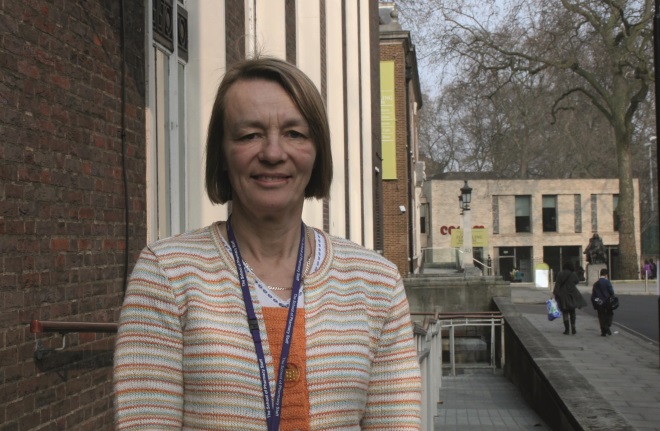
Source: Elizabeth Sukkar / The Pharmaceutical Journal
Felicity Smith, a UCL professor of pharmacy practice, hopes the alliance of the pharmacy schools will help the profession on a global scale, such as, identifying services that could work anywhere
When Felicity Smith, a UCL professor of pharmacy practice, first heard about the initiative she considered it from the point of view of what the three schools could do for the pharmacy profession on a global scale.
“We can aspire to prepare our students to be part of an international professional community, in terms of education, research and services to support medicines use in all communities,” says Smith. The schools can learn from each other about the different ways patient care is delivered.
She hopes the collaboration will build on the work that UCL has already done on the ‘Global pharmacist’ project, which developed methods to help integrate teaching about global and development issues into undergraduate curricula.
Ultimately, it can identify what types of services from pharmacists will work anywhere, and what is context or country specific, she adds.
Drug discovery: upping the academic game
All three schools have drug discovery programmes in a wide range of areas – including nanotechnology, cancer, HIV, cardiovascular disease and Parkinson’s disease – so it is no surprise that PharmAlliance is seeking to make gains in this field.
UCL is active in neuroscience. In February 2015, for example, it received £10m from Alzheimer’s Research UK to set-up a drug discovery centre to address the lack of effective treatments for the condition. And the close proximity of UNC-Chapel Hill and GlaxoSmithKline (GSK) in the research triangle park in North Carolina, one of the company’s R&D sites in the US, has meant that they have staff that have got industrial experience who are able to look at what a university can do in drug discovery.
At Monash University there is a pharmaceutical research centre that has helped many small companies in Australia develop promising drug candidates. One such molecule is the anti-influenza drug Relenza (zanamivir), a medicine now marketed by GSK.
Monash is now working on a US$16.6m project with GSK to develop an oxytocin inhalation device to prevent fatal blood loss following labour for women in developing countries. This major initiative hopes to result in a low-cost device — which avoids the need for injectable oxytocin — to prevent the deaths of tens of thousands of women each year.
“If you can imagine Monash doing that on its own, just think what the three of us can do together,” says Craig.
Universities are increasingly involved in drug research, but it’s becoming an expensive business, with the cost of developing a drug estimated to have risen from US$802m in 2003 to US$2.6bn in 2014. Once a university discovers a drug, it is usually wise to find an industry partner.
“We would not try to become a pharmaceutical company so the decision has to be made at which point do you hand over to a company. Do you form a spin-out? You can form a spinout to take the molecule to different stages of development,” says Craig.
The number of molecules that are coming onto the market that originated in universities is considerable, according to Craig. “The idea that universities do not have the infrastructure to at least provide the building blocks for bringing a drug to market is no longer an argument with traction,” he says. But universities can’t do everything. “For example, we can’t market the drugs.”
Universities are not afraid to go into areas that industry might deprioritise. Craig highlights areas such as neuroscience, drugs for use in pregnancy, stratified medicines for children and adults, rare diseases, neglected diseases and the palatability of medicines.
Industry is rethinking the way it is approaching drug discovery, points out Blouin. Many companies are moving away from early drug discovery because the risk is so high. They are turning to universities to accept some of this risk and do some of the early exploratory science to discover novel targets and create new drugs.
Universities should cover the basics over IP rights before they sign an agreement, that is, before the research starts as problems could arise
UNC-Chapel Hill is already working with others on kinase inhibitors, which target cancer among other diseases, and this could be a potential area for collaboration. In 2013, a faculty member formed a spin-off company in Chapel Hill, Meryx, based on kinase research and is moving forward into clinical trials. “This is a UNC project, but there are opportunities to do something like this across the PharmAlliance,” Blouin says.
In terms of challenges, one area any alliance needs to agree upon is how intellectual property (IP) rights will be shared between the parties should a valuable discovery be made. Authorship is important to a researcher and sometimes it is difficult to work out who contributed the most.
“Universities should cover the basics over IP rights before they sign an agreement, that is, before the research starts as problems could arise,” warns Borrell-Damian. ”The secret of success is to discuss the parameters around IP rights before signing agreements.”
However, the members of the PharmAlliance don’t seem too concerned. IP provisions will be agreed on a project-by-project basis. “We are three mature pharmacy schools,” says Craig. “We have all got strong support systems in our respective universities and are totally used to the idea of using those services to ensure that there is a fair and equitable agreement on IP. I don’t think the three partners envisage IP as being a problem.”
Funding and next steps
The three schools are contributing US$500,000 each to kick-start the project and encourage faculty collaboration, and by late 2015 they hope to initiate the first projects. The deans are not specifying which projects they will work on initially, but want to target “really big problems”.
“Problems that we could probably not take on by ourselves. Problems that have a global tone to them…because we have an altruistic intent as part of this alliance,” says Blouin.
PharmAlliance will be accessing major national and international funding schemes — those that are looking to support transformative changes — and especially those looking for a multi-disciplinary approach to address global questions, declares Monash’s Charman. There are several bodies that fund international projects, including the EU’s Horizon 2020, the US National Institutes of Health and the Bill and Melinda Gates Foundation. Some of the projects could have funding of up to £10m, hopes Craig.
At the end of five years, the deans will sit down and make an honest assessment on whether they have reached their goals. “What we really need to do is look down from above and see what strings together really well across the three bodies,” Craig says. They still have a lot of work to do.

